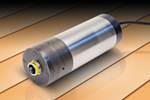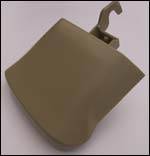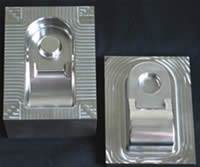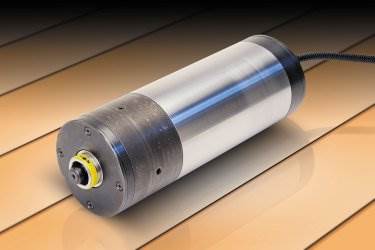HSK Fact and Fiction
Get the facts on what to consider when purchasing and using HSK tooling.
With the exponential growth of machining technology over the last 10 years, HSK tooling—an acronym for a phrase that roughly trans-lates as “hollow shank tooling”—has become almost common in the U.S. This article will serve to explain several ex-tremely important things to bear in mind when purchasing and using HSK tooling.
HSK Points to Remember
The first point to remember is that the tolerancing of the HSK toolholder taper is much tighter than that of any of the 7/24 taper shanks on the market today. For an HSK63A, the taper tolerance is in the neighborhood of several microns, or roughly one and a half ten-thousandths of an inch. Think about holding a bore size within a tenth and a half. Naturally, the tolerance of the corresponding spindle taper is even smaller.
With that in mind, take a look at the following comments given by various people in the tooling and machining industry:
- “The tolerance of the taper doesn’t really matter, as long as it fits in the spindle.”
- “We don’t use gauges to make our tools; we blue them and fit them to the spindle shaft”. Conversely, and from the same company, “We don’t use gauges on our spindle tapers, we grind them in using toolholders with blueing on them.”
- “HSK tools can’t be used to take more than a few thousandths of material in a pass.”
- “If that HSK tool gets rusty, just buff off the rust. The taper expands, so it doesn’t matter.”
- “Our toolholders are made to our own company specifications, and those are tighter than the DIN or ISO standard.”
- “Can you re-certify these toolholders we bought from you? We’re using them as our gauge masters!”
The point? There is way too much misinformation out there!
The Decision-Making Process
The first step in the decision-making process should be information collection. If a salesman tells you that “You can’t do this” or that “This is the only way to do it,” then you need to question him and find out why.
For example, a salesperson in a shop made the statement that HSK40E tooling couldn’t be used for anything but a light finishing cut because it doesn’t have drive keys. This salesperson overlooked the fact that the torque transmission figures promulgated by the Aachen Committee were generated by tooling without drive keys!
Gather Standard Information
While you are out collecting information, remember that all of the facts and information regarding the HSK system are in the public domain. That was the original reason for developing it, to make life easier and less expensive for machinists; not more expensive.
You don’t need to buy a book or pay any royalties to get the facts; you need to make your decision. Any reputable manufacturer can show you a copy of the applicable standard.
The Aachen Committee results are available in English and have been widely disseminated. There have been various books published and sold here in the States purporting to “Tell All” about the HSK standard, and there has been incorrect information included. Get your information from the standards and other source documents, not second-hand.
When you prepare to buy HSK tooling, bear in mind that all of the performance data used to compare it to other tooling standards comes from tests conducted using tools and spindle tapers that were manufactured strictly to the DIN standards.
If the tooling you buy is out of tolerance, it may well fit in a spindle, but you won’t get the performance out of it that you would out of a tool made to spec. If the spindle shaft or spindle that you buy will accept the toolholders you have, but isn’t to standard, you may wind up not getting any of the benefits the HSK system has to offer.
Certification and Traceability
Insist on certification and traceability. There is no substitute. If you are committing a sizable chunk of funding to purchase toolholders, don’t hesitate to ask how they are made, how they are inspected and how they are certified.
Ask how long the company has been manufacturing that style of holder, if, indeed, they do manufacture it. If someone offers to sell you an HSK63A collet chuck for $75.00, you can probably take a pretty good guess as to the quality level of that chuck. Reasonably, any vendor should be willing to talk about the gauging that they use, and the certification process for both the tooling and their gauges.
Spindles and Spindle Shaft
When you are buying a spindle or a replacement spindle shaft, it gets even deeper.
Supplier Gauging
Very few manufacturers have the gauging necessary to properly grind the HSK taper in a spindle shaft. By the time you get to the level of the rebuilder or the job shop making an HSK spindle shaft for a manufacturer, the likelihood of finding a good, certified gauge is slim indeed.
There are actually spindles made by companies using blueing and toolholders as a gauge, and service people for those companies using hand-held die grinders to relieve the drive keys inside the taper to allow a toolholder to fit. This is on a spindle taper with tolerancing in the micron range … is your hand that steady?
Before committing to buy a spindle or a spindle shaft from a company ask the following:
- What type of gauging are you using to verify the taper and what is your certification program for the shafts?
- Will you guarantee that the taper meets the standard that it is purportedly being manufactured to?
- Do you have a scheduled gauge master recalibration/ recertification program in place?
- Are your workers conversant with the gauging and with the applicable standards?
All of these questions asked before a purchase, can save you thousands of dollars and much heartache down the line.
Shop Gauging
Now that you’ve heard enough about your suppliers gauging, let’s talk about your own! Many shops have decided that due to the (relatively) high cost of HSK toolholders, they would like to be able to check the holders that they buy. This is strongly encouraged, because, frankly, it thins out the competition.
Gauging is available in several different configurations to suit your needs. As far as cost, you may spend up to about $10,000 to get gauges and masters—whether you’re using air-gauging or hard gauging—but if you are buying large quantities of tooling, or maintaining several HSK machine tools in a shop, then you will amortize the cost of the gauging very quickly.
Storage
Last but not least, let’s talk about where you’re going to put all that nice new HSK tooling. Many shops store their HSK tools in much the same way as they store their 7/24 taper tools, which leads to the need for more replacement toolholders.
Keeping in mind, once again the tolerances that the HSK system uses, it’s important to store the tools in such a way that they don’t become damaged by contact with other tools, chips, dirt, etc.
The best storage solutions have some type of door to keep off curious hands and individual pockets to hold the tools. Many people overlook this part of the equation, but proper care of your toolholders is as important as choosing the correct ones in the first place.
Realize the Benefits
Finally, don’t let all of the industry-speak about this system scare you off. There are many benefits to it for those machining at all speeds and loads. Get your facts and crunch the numbers yourself.
Related Content
Fundamentals of Designing the Optimal Cooling System
The right mold components can help improve mold cooling and thereby produce higher-quality parts.
Read MoreMachine Hammer Peening Automates Mold Polishing
A polishing automation solution eliminates hand work, accelerates milling operations and controls surface geometries.
Read MoreTreatment and Disposal of Used Metalworking Fluids
With greater emphasis on fluid longevity and fluid recycling, it is important to remember that water-based metalworking fluids are “consumable” and have a finite life.
Read MoreRevisiting Some Hot Runner Fundamentals
What exactly does a hot runner do? If you’ve been in the injection molding industry for any length of time, you might think the answer is obvious, but it is not.
Read MoreRead Next
Machining Molds with Negative Stock Shutoffs
Negative stock shutoff can help you make better molds in less time. Here is a clear definition and description of the process. While the concept is fairly simple, the implementation can be challenging.
Read MoreThe Keys to Successful High-Speed Machining
Moldmakers will reap all the benefits of high-speed machining with the right mix of machine tool, tooling and programming.
Read MoreHSK: The Critical Link in High-Speed Milling
As high-speed machining and milling becomes more popular, moldmakers are looking for alternatives to their traditional low-speed toolholders.
Read More








.png;maxWidth=300;quality=90)












